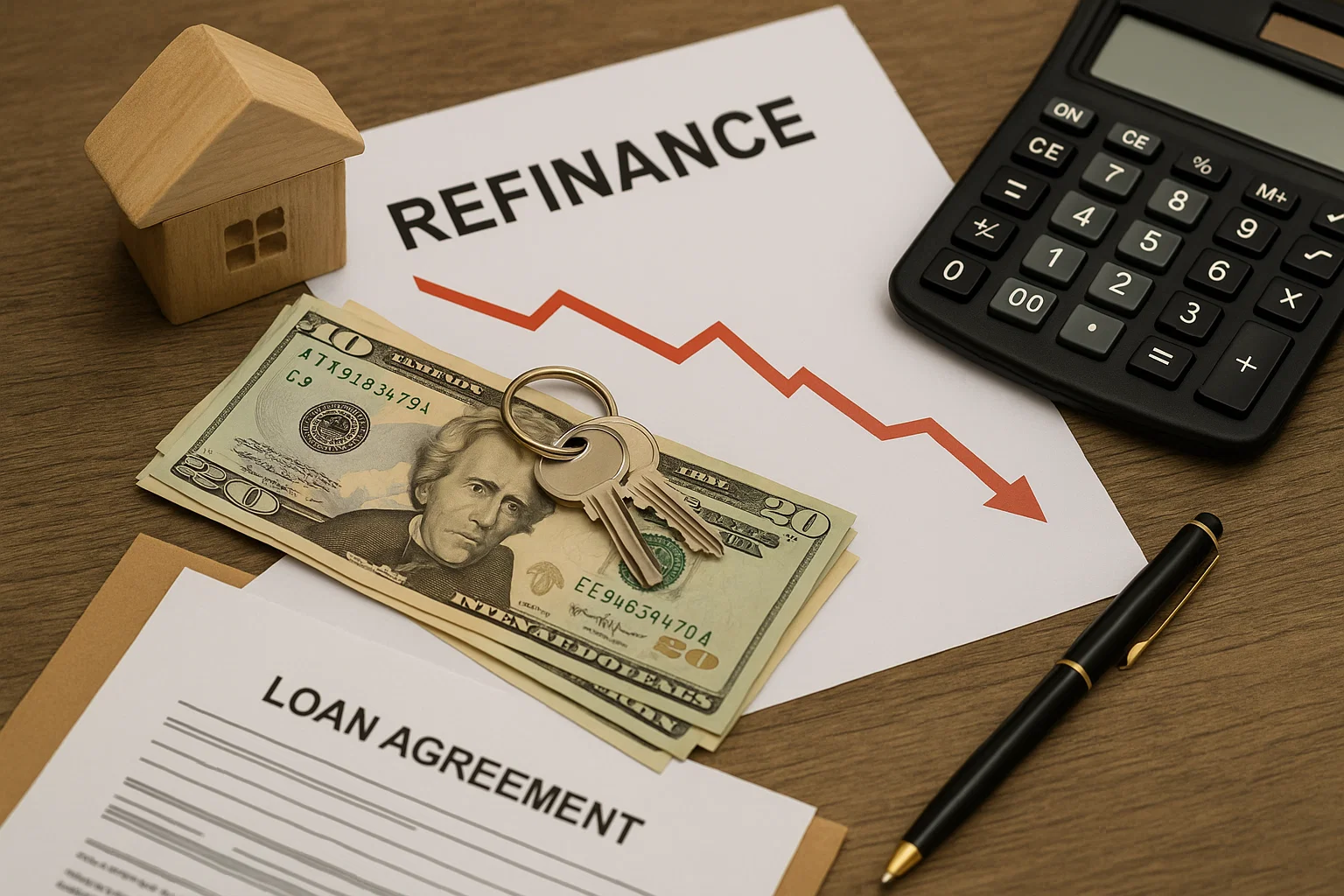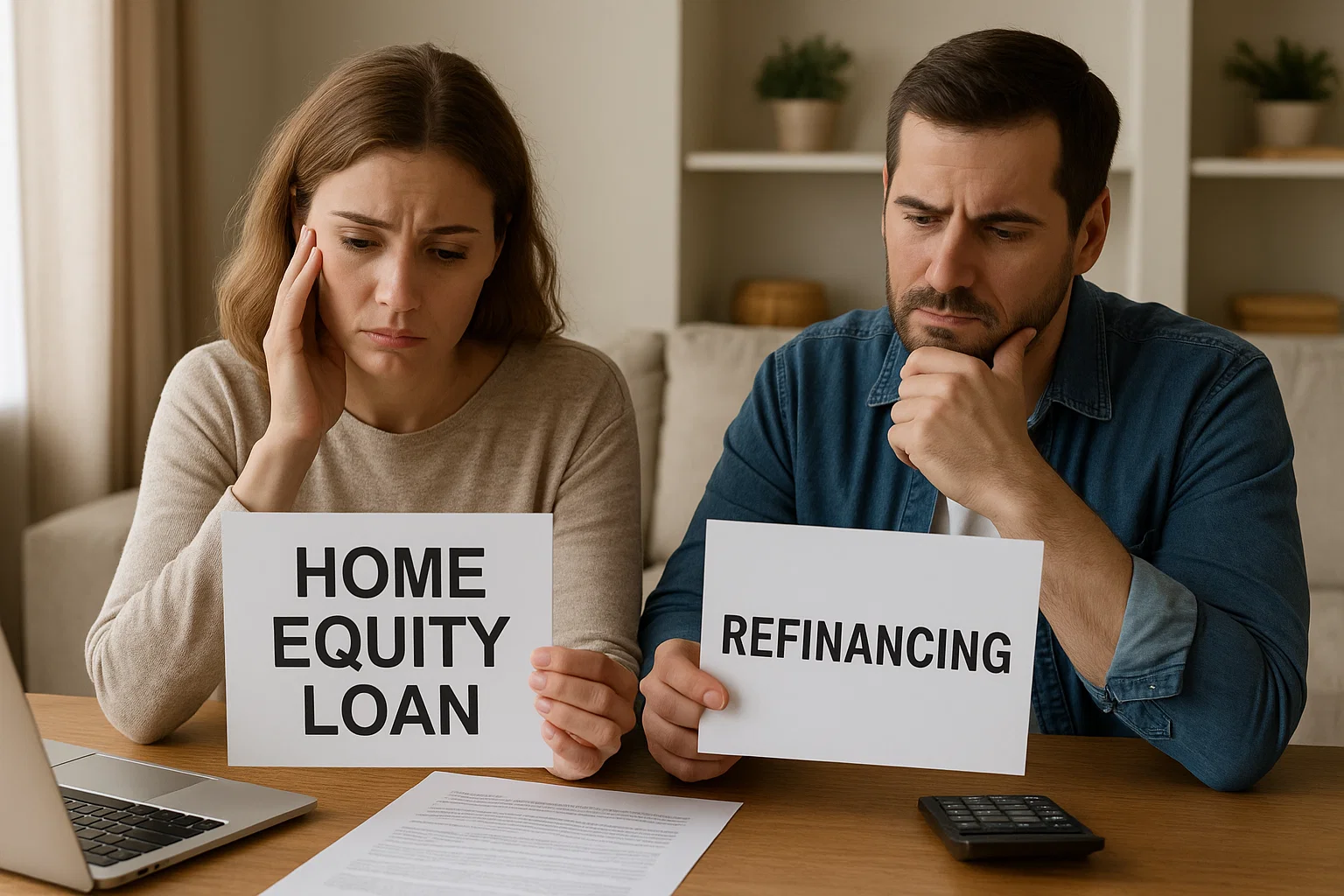.png)
Mortgage refinancing is recognized as a powerful financial tool available to homeowners. It presents opportunities to lower monthly payments, save money on interest charges, or effectively tap into the equity that has been built up in the home. However, refinancing is a financial decision that demands careful and thorough consideration, as it involves both significant advantages and potential drawbacks. Understanding the balance between these pros and cons is essential to making a choice that aligns effectively with your long-term financial health and personal circumstances. This comprehensive guide provides a detailed examination of the advantages and disadvantages of refinancing, equipping you to determine if it is the right move for your specific situation and enabling you to make a fully informed decision that supports your financial goals.
I. The Advantages of Refinancing
When refinancing is timed correctly and structured to align with your specific financial objectives, it can provide several compelling benefits that have the potential to improve your financial position for years to come.
Securing a Lower Interest Rate and Monthly Payment
The most frequent reason homeowners choose to refinance is to capitalize on lower market interest rates. Achieving a lower rate can substantially reduce the required monthly mortgage payment. This reduction in monthly outflow frees up cash flow, which can then be utilized for other expenses, investments, or savings. Even a relatively small reduction in your interest rate can result in substantial savings over the entire duration of the loan.
For instance, consider a $300,000 mortgage. If the homeowner manages to reduce their interest rate from 5% down to 3.5%, they could potentially save approximately $300 per month. Furthermore, this seemingly modest monthly saving translates into tens of thousands of dollars saved over the full term of the loan. This extra cash flow can be strategically redirected, perhaps toward building retirement savings, establishing or growing emergency funds, or paying down other existing high-interest debt. The cumulative effect of these savings greatly enhances your overall financial position and provides substantial flexibility within your monthly budget.
Shortening Your Loan Term
If a homeowner’s income has increased since they initially secured their original mortgage, they might consider refinancing from a 30-year term to a 15-year or 20-year term. While this strategy typically results in a higher required monthly payment, the benefits include paying off the home much faster, accelerating the rate at which equity is built, and saving a considerable amount in total interest charges over time.
Homeowners who opt for shorter loan terms often find the increased monthly payment to be manageable, especially given their improved financial standing. Moreover, the psychological benefit associated with owning their home outright sooner is often highly valued and cannot be overstated. An additional financial advantage of this strategy is that shorter-term loans generally come packaged with lower interest rates. This lower rate partially counteracts the effect of the higher principal payments, making the overall cost more efficient. This approach is particularly appealing to homeowners in their 40s and 50s who are focused on ensuring their mortgage is completely paid off prior to entering retirement.
Switching from an ARM to a Fixed-Rate Loan
Homeowners currently holding an adjustable-rate mortgage (ARM) are exposed to the risk of their mortgage payments increasing over time as interest rates fluctuate in the broader market. Refinancing out of an ARM and into a fixed-rate mortgage provides crucial stability and predictability, ensuring that the monthly payment will not change. This fixed payment makes long-term budgeting and future financial planning much easier.
This stability is particularly valuable during uncertain economic periods or when there is a clear trend of rising interest rates. While ARMs can be initially beneficial due to their lower introductory rates, the fixed-rate option is a prudent decision for long-term financial stability, especially as the adjustment period for the ARM approaches. Locking in a fixed rate protects the homeowner from potential "payment shock". Many homeowners who initially chose ARMs with the intent to sell or refinance quickly often find themselves staying in the property longer than originally anticipated, making the conversion to a fixed rate a sound choice.
Accessing Home Equity with a Cash-Out Refinance
A cash-out refinance mechanism allows the homeowner to borrow against the equity they have diligently built in their home. This specific type of refinance can be a cost-effective method for funding significant home renovations, consolidating high-interest debt, covering educational expenses, or managing other major expenses. Utilizing mortgage rates for these funds is often cost-effective because mortgage rates are typically much lower than the interest rates associated with personal loans or credit cards.
For example, a homeowner burdened with $50,000 in credit card debt carrying an 18% interest rate could refinance to access that same amount through their mortgage at a 4% rate. This switch can result in savings of thousands of pounds in interest annually. However, the sources emphasize the importance of using these cash-out funds judiciously. It is crucial not to merely convert short-term debt into long-term mortgage debt without simultaneously addressing the underlying spending habits that led to the original debt accumulation. Home equity should be regarded as a valuable financial resource capable of funding investments directly related to the property or supporting other wealth-building activities.
Eliminating Private Mortgage Insurance (PMI)
If a homeowner made a down payment of less than 20% when they secured their original loan, they are likely required to pay for Private Mortgage Insurance (PMI). PMI usually costs between 0.5% and 1% of the loan amount on an annual basis. Once the home's market value has appreciated and the homeowner has achieved at least 20% equity, they gain the ability to refinance specifically to eliminate this extra monthly cost, resulting in immediate savings.
For a mortgage loan amount of $250,000, PMI could be costing the homeowner between $100 and $200 every month. This recurring expense provides no direct financial benefit to the homeowner. Rising home values, prevalent in many property markets, have helped numerous homeowners reach the 20% equity threshold faster than they might have expected, making the elimination of PMI through refinancing a highly attractive option. Unlike interest rate reductions, which depend on prevailing market conditions, the savings generated by eliminating PMI are often permanent and immediate.
II. The Disadvantages and Risks of Refinancing

While the potential financial benefits of refinancing are undeniably attractive, the process is not without its potential downsides and inherent risks. Understanding these possible risks is absolutely essential for making a fully informed and responsible decision.
Significant Closing Costs
It is crucial to understand that refinancing is not a free process. Homeowners are required to pay closing costs, which typically range from 2% to 6% of the new loan amount being secured. These fees encompass various charges, including appraisal fees, fees for title insurance, origination fees charged by the lender, credit report fees, and sundry administrative charges.
Because of these costs, it is vital to calculate your "break-even point". The break-even point is defined as the length of time it will take for your accumulated monthly savings to fully cover the total cost of these initial closing fees. If you anticipate selling your home before you reach this break-even point, then refinancing is likely not a financially sound decision.
For example, if the total closing costs amount to $6,000, and the refinancing only saves you $150 per month, your break-even point is calculated to be 40 months. If your long-term plan involves moving within three years (36 months), you would fail to recoup the costs associated with the refinance. Some lenders may advertise "no-closing-cost" refinances, but the source notes that these options typically carry higher corresponding interest rates, which will ultimately cost the borrower more money over the extended loan term. Homeowners should always compare the total long-term cost of different refinancing options instead of focusing exclusively on the upfront expenses.
Restarting or Extending the Loan Term
A significant potential pitfall occurs if you choose to refinance into a completely new 30-year loan after you have already made payments on your original mortgage for several years. In this scenario, you are essentially "resetting the clock" on your debt repayment. Although the new monthly payment may appear lower, you could very easily end up paying substantially more in total interest over the full life of this new, extended loan.
Consider a scenario where you have diligently paid on a 30-year mortgage for eight years. If you decide to refinance into a new 30-year loan, instead of having only 22 years remaining on your debt, you now face a full 30 years of payments ahead. Even if the new loan has a lower interest rate, the extended timeline often results in paying more total interest overall. To avoid falling into this pitfall, homeowners should strongly consider refinancing into a loan term that either matches their remaining term or, ideally, is shorter than their remaining term. Alternatively, they could commit to making consistent, extra principal payments to ensure they adhere closely to their original payoff schedule.
Increased Monthly Payments
If a homeowner’s strategy involves refinancing specifically to secure a shorter loan term—a common tactic to save money on interest—their resulting monthly payments will almost certainly increase. Before proceeding, you must be absolutely certain that your current budget can comfortably accommodate this higher payment without inducing any kind of financial strain.
While the accelerated pace of building home equity is a highly appealing prospect, homeowners must ensure they maintain adequate cash flow. Sufficient cash flow is necessary for critical financial areas such as emergency savings, consistent retirement contributions, and working toward other predetermined financial goals. It is recommended that homeowners run their numbers carefully and "stress-test" their budget. This stress test ensures that they can manage the higher payment even in the event of an unexpected income decrease or the emergence of unforeseen expenses. Financial advisors often suggest that for maintaining a healthy financial position, your total housing payment should ideally not surpass 28% of your gross monthly income.
Reduced Home Equity
Opting for a cash-out refinance inherently decreases the amount of equity the homeowner has built up in the property. Essentially, this process converts the accumulated home equity directly into long-term debt. This transaction can become particularly risky if local home values experience a decline, potentially leading the homeowner to owe more money than the home is actually worth—a serious financial situation commonly referred to as being "underwater" or having negative equity.
Furthermore, reducing home equity diminishes the financial cushion available for the future and limits the homeowner's options if they later need to sell the property or attempt to refinance yet again. Having less equity in the home also makes the homeowner more vulnerable during broader economic downturns and directly reduces the net amount of money they would receive upon selling their home. Before a homeowner pursues a cash-out refinance, they must carefully evaluate whether the intended use of those funds will generate sufficient value to fully justify the increased debt load and the resulting reduced equity position.
Temporary Impact on Your Credit Score
The act of applying for a mortgage refinance triggers a process known as a hard credit inquiry, which typically results in a temporary lowering of the applicant's credit score by a few points. In addition, when the old mortgage is closed and a new one is opened, this transactional activity can affect the average age of the borrower's accounts, a factor specifically used in the calculation of the credit score.
Although these credit score impacts are generally minor and temporary in nature, they could become problematic if the homeowner is simultaneously planning other major financial moves in the immediate future. Such moves could include purchasing a new car, applying for a business loan, or seeking out other forms of credit. The impact on the credit score usually recovers within a few months, provided the homeowner maintains a diligent practice of making on-time payments consistently. If a homeowner intends to apply for other forms of credit within the next six months, it may be advisable to carefully time their mortgage refinance application accordingly.
III. Additional Considerations and The Right Decision
Making the right refinancing decision involves looking beyond the immediate pros and cons and taking into account broader economic factors and personal planning.
Market Timing and Interest Rate Trends
Refinancing decisions should never be made in isolation from the prevailing broader market conditions. While no one can perfectly time the market, having an understanding of general interest rate trends can substantially assist in making superior decisions. If current interest rates are situated at historic lows, it presents an excellent potential opportunity to lock in substantial long-term savings. Conversely, if interest rates are demonstrably rising but still remain below your current rate, acting sooner rather than later is a logical and sensible course of action.
Homeowners are advised to consistently monitor rate movements and be ready and prepared to act decisively when a favourable opportunity presents itself. Many mortgage lenders offer the option to lock in a specific rate for a period, typically 30 to 60 days, which provides protection against potential rate increases while the loan processing period takes place.
Tax Implications
For many homeowners, the interest paid on their mortgage is tax-deductible. However, the sources note that changes to tax laws have had an impact on the value and availability of this deduction. It is important for homeowners to understand precisely how refinancing will affect their overall tax situation.
Furthermore, in the case of a cash-out refinance, the deductibility of the resulting interest depends critically on how the borrower utilizes the borrowed funds. Interest on funds used specifically for documented home improvements is generally deemed deductible. Conversely, interest on funds utilized for other general purposes may not be deductible. It is strongly recommended to consult with a qualified tax professional to fully understand all the potential implications of a refinancing decision.
Making the Right Decision: A Checklist

To definitively determine whether refinancing constitutes the right choice for your circumstances, several critical points must be considered carefully.
Your Financial Goals and Situation
First, be unequivocally clear about what you aim to achieve through refinancing. Are your primary goals to reduce the monthly payments, pay off the mortgage debt faster, access immediate cash, or eliminate the expense of PMI? Your clearly defined goals should always serve as the guiding force for your resulting refinancing strategy.
Second, honestly assess your current financial situation. This assessment must include a review of your current income, your credit score, and your debt-to-income ratio. The sources indicate that lenders typically require a minimum credit score of at least 620 for conventional refinances, though the absolute best available rates are usually reserved for applicants with scores above 740.
Your Long-Term Plans and the Break-Even Point
You must carefully consider how long you realistically plan to remain living in your current home. If there is a plan to move or sell the property within just a few years, the associated costs of refinancing are likely to outweigh any potential benefits realized. As a general rule, you should plan to stay in the home long enough not only to reach your calculated break-even point but also to stay well beyond it to ensure savings are realized.
The underlying mathematics must be rigorous. Homeowners should meticulously calculate the total long-term cost of the proposed new loan, alongside determining their break-even point. Utilizing reliable online calculators or working directly with a financial advisor can help model various different scenarios and fully understand the complete financial impact of the decision.
Seeking Professional Guidance
Finally, consider engaging the services of a mortgage broker or a financial advisor. These professionals are equipped to provide personalized recommendations tailored to your specific financial situation. They possess the expertise to help you successfully navigate the inevitable complexities of the process and identify opportunities for savings that you might otherwise overlook.
Refinancing, when executed correctly, can serve as a smart financial move, providing both immediate relief and valuable long-term savings. However, it remains absolutely essential to weigh the full spectrum of pros and cons within the specific context of your personal financial situation. By seeking professional advice, engaging in thorough research, shopping around carefully, and comparing offers from multiple lenders, homeowners can make a decision that will benefit them for years. It is critical to read all accompanying documents carefully before committing to any new loan. With thorough preparation and realistic expectations firmly in place, refinancing stands as a valuable and powerful tool within your financial planning arsenal.

Alex Chen

Alex Chen













Get in touch with a loan officer
Our dedicated loan officers are here to guide you through every step of the home buying process, ensuring you find the perfect mortgage solution tailored to your needs.
Options
Exercising Options
Selling
Quarterly estimates
Loans
New home

Manténgase siempre actualizado sobre artículos y guías interesantes.
Todos los lunes, recibirás un artículo o una guía que te ayudará a estar más presente, concentrado y productivo en tu vida laboral y personal.





.png)
.png)
.png)
.png)
.png)
.png)
.png)
.png)
.png)
.png)
.png)
.png)
.png)
.png)
.png)
.png)
.png)
.png)
.png)
.png)
.png)
.png)